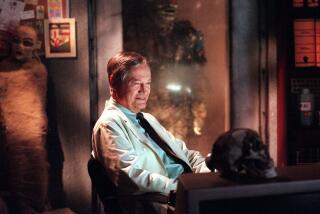Oscar glory, at last
At first glance, it seemed like a slight.
Just two days after the Academy of Motion Pictures Arts and Sciences announced in June that it was expanding the best picture category from five to 10 nominees, it dropped another bombshell on awards-season purists. Winners of the honorary Oscars, also known as the testimonial awards, would be presented their golden statues at a dinner in November instead of during the televised event in March, when they will be merely “acknowledged.”
But the academy has maintained all along that this new event, taking place Saturday at the Grand Ballroom at Hollywood & Highland, is the best way to honor the talented men and women whose distinguished careers and contributions to the craft of moviemaking have set themselves apart from their peers.
“You are able to take the time to properly celebrate these people,” says Bruce Cohen (“Milk”), who is producing the intimate and un-televised honorary awards show. “One of our early inspirations was the early Oscars that used to be at the Hollywood Roosevelt Hotel and not televised, with dinner and people sitting around tables. One of the themes of the evening is toasts. People who have had a long relationship with the honorees are going to stand up from the table and give a toast to the room celebrating the person. We are hoping that it’s going to be a very warm, old-friendly Hollywood feel to it.”
This year’s honorees -- actress Lauren Bacall, 85; producer-director-writer Roger Corman, 83; and “The Godfather” cinematographer Gordon Willis, 78 -- will be in attendance. Producer and former studio executive John Calley, 79 (“Remains of the Day”), the recipient of the Irving G. Thalberg Memorial Award, will be unable to attend due to health issues.
Cinematic luminaries such as Annette Bening, Jonathan Demme, Caleb Deschanel, Kirk Douglas, Tom Hanks, Anjelica Huston and Quentin Tarantino will be on hand. It has to be especially exciting for Corman and Willis, two industry legends who have spent their careers behind the camera and now find themselves in the spotlight, receiving their industry’s highest honors.
Roger Corman
The best film schools are well known -- USC, UCLA and New York University to name just a few. But for many working in Hollywood today, the greatest film institution is actually Roger Corman.
Not only did Corman turn independent film on its ear over the last five decades, making entertaining, low-budget horror films, comedies and dramas often in less than two weeks, he also gave such Oscar-winning and nominated directors as Francis Ford Coppola, Martin Scorsese, James Cameron, Ron Howard, Jonathan Demme and Peter Bogdanovich their big breaks.
“Roger Corman is responsible for the ‘New Hollywood,’ ” says Bogdanovich, who directed his first film, 1968’s acclaimed “Targets,” for Corman. “He has made a tremendous impact as a director himself and made very stylish horror films and made them fast and cheap and made them look good. If it wasn’t for Roger you wouldn’t have Jack Nicholson or Francis Coppola or Marty or Jonathan Demme.
“Roger was fiercely independent,” adds Joe Dante (“Gremlins”), who began cutting trailers for Corman in the 1970s before making the 1978 hit “Piranha” for him. “He mostly worked with American International Pictures, which was essentially an independent company. I like the way he made his pictures. I liked the speed, the economy, the style.”
At his peak in the early 1960s, Corman was making as many as seven movies a year, including the classic horror comedy “Little Shop of Horrors,” which he, as the story goes, shot in just two days. He also made stylish adaptations of Edgar Allan Poe thrillers.
Corman says that his degree in engineering from Stanford helped him make movies economically by knowing how to plan. “I started as a writer,” he says, relaxing on a recent morning in his office in Brentwood. “When I started directing possibly because of the engineering or maybe because the way the brain is wired, I understood editing and all the technical elements of making films. I learned that on the job quickly.”
But he felt unsure working with actors, so he enrolled in an acting class. It was in that class he met a young Nicholson, whom he cast in 1958’s “The Cry Baby Killer.” “I simply felt he was not only the best actor in the class and although he never made a film he was better than most of the actors I had been working with.”
Corman began to give young filmmakers their chance after some financial success. “I had made a little bit of money and the normal way people would invest was in the stock market or real estate,” he says. “I said to myself ‘I don’t really know anything about the stock market or real estate, but I think I know something about motion pictures.’ As a young guy around Hollywood, I knew the other guys around Hollywood. I thought the thing to do is back somebody in a low-budget film.”
So he first chose Irvin Kershner (“The Empire Strikes Back”), who did a picture in 1958 called “Stakeout on Dope Street.” “We sold it to Warner Bros. and had a substantial profit. I thought this was a great way to invest.”
Then he gave his “ace assistant” Coppola the opportunity to direct 1963’s “Dementia 13,” which was also a hit. And so Corman continued discovering and nurturing filmmakers.
Corman is still producing films -- in fact his first Web series, “Splatter,” which he made for Netflix, concludes Friday -- but he admits he’s making fewer films than before.
“We are making three to five films a year,” he says. “The market for low-budget films is the lowest I have ever seen in my life. Guys who I have known for many years, many of them younger than I, have simply retired. I am one of the few who are still there.”
And retirement is not an option for Corman. “I love to make films,” he says.
Though several of the directors whom he championed had sent a letter to the academy’s board of governors to consider Corman, the filmmaker says he never thought he would ever get the award, “because I make low-budget films. Then they called me one night and said we voted to give you an award. I was really surprised.”
Gordon Willis
Cinematographer Gordon Willis earned a nickname of the “Prince of Darkness” for his fearlessness in his use of darkness and shadows in such classic films as “The Godfather” trilogy or his brilliantly impressionistic mastery of black and white in Woody Allen’s films “Manhattan” and “Zelig.”
As for the honorary Oscar, he says “it’s a nice surprise at this point in life.”
His last film was 1997’s “The Devil’s Own.” “My eyes are sort of failing to a degree,” he says in a steady voice. “You know, I have seen enough.”
Willis came from a show business family. His father was a makeup artist at Warner Bros.’ Brooklyn-based studio. “I sort of hung out there. Then I actually wanted to be an actor when I was a kid. Luckily, that passed.”
As a teenager, he turned to photography. While in the Air Force, he joined a motion picture documentary unit. When he got out of the Air Force, he worked his way up from a magazine loader to cinematographer, eventually getting in the union on the East Coast. After shooting commercials, he made his feature debut as director of cinematography on 1970’s “End of the Road.”
“I came out of it really well,” he says. “People looked at it and said, ‘This is new.’ ”
It was a style that he applied to his work on Coppola’s “The Godfather.” Initially Paramount was upset about how dark the film looked. “Francis was also having a lot of problems with the studio, but we both sort of held our ground, so when we did ‘Part II,’ nobody bothered us.”
Still, he says, “I had a lot of arguments with Francis on the first one because there was a lot of film student left in Francis and I think there still is. I am a very specific person. I do what I think and I say what I think. I don’t believe in a lot of options when you shoot movies.”
Saturday will mark his first Oscar win, but Willis is no stranger to the nomination. Interestingly, it wasn’t the first two “Godfather” films or 1979’s “Manhattan” that put him on the short list. Instead, he earned nominations for 1983’s “Zelig” and 1990’s “The Godfather: Part III.”
“No one who is in the subterranean world of Oscar nominations could ever figure it out,” he says. “I think it tended to be infuriating to a lot of people here that I was living on the East Coast. I didn’t have white shoes and I didn’t play golf.”
--
More to Read
Only good movies
Get the Indie Focus newsletter, Mark Olsen's weekly guide to the world of cinema.
You may occasionally receive promotional content from the Los Angeles Times.










